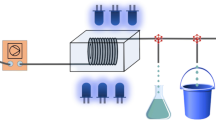Summary
Liquid chromatography in open tubes at flow rates around 0.1 cm · s−1 and less can generate an enormous number of theoretical plates but suffers from long analysis times. The Golay and van Deemter equations are also obeyed with high accuracy.
If straight tubes of circular cross section and very smooth inner surface are used, secondary flow effects can be neglected. Thus the plate height should depend only on the flow velocity and the number of theoretical plates should decrease with increase in linear flow, whereas the number of plates per unit time should be constant.
Under turbulent conditions, however, the plate height seems to be more or less independent of linear flow over a wide range. Increasing the flow to several hundred cm · s−1 causes, for example, 0.2 mm ID capillaries to show the reverse effect and a slight decrease in plate height is found. Alkali treated and silanized capillaries below 100 μm i. d. deviate from the Golay prediction before turbulence occurs and a relative decrease in the plate height and thus higher efficiency is found possibly caused be secondary flow effects in the coiled tube or the roughness of the inner walls. These effects allow an increase in the efficiency of given open-tubular systems simply by increasing the solvent velocity drastically. Although plate heights are in the range mm to cm, efficiencies, in theoretical plates per second, similar to classic HPLC, are found. Therefore the quite interesting possibility of overcoming the well-known restrictions of classical HPLC to achieve high efficiency liquid chromatograms exists.
Similar content being viewed by others
References
M. J. E. Golay, in D. H. Desty (Ed.), Gas Chromatography, Butteworth, London, 36 (1958).
G. I. Taylor, Proc. Roy.-Soc. London,A225, 473 (1954).
I. G. Atwood, J. E. Golay, J. Chromatogr.,218, 97 (1981).
K. Hofmann, I. Halász, J. Chromatogr.,173, 211 (1979).
I. Halász, J. Chromatogr.,173, 229 (1979).
R. Tijssen, Anal. Chim. Acta,114, 71 (1980).
H. Bauer, Habilitationsschrift, University of Tübingen (1986).
R. Tijssen, Separation Science and Technol.,13, 681 (1978).
H. Bauer, Y. Zhang, J. Chromatogr. in press.
H. Bauer in: Chemielabor 1987, J. Ebel and W. Dorner (Ed.), Verlag Chemie, Weinheim, 75 (1987).
F. Bonjakovic, Technische Strömungslehre, Th. Steinkopf. Dresden, 468 (1972).
Author information
Authors and Affiliations
Rights and permissions
About this article
Cite this article
Bauer, H. Open-tubular liquid chromatography under turbulent and secondary flow conditions. Chromatographia 27, 238–242 (1989). https://doi.org/10.1007/BF02260454
Received:
Accepted:
Issue Date:
DOI: https://doi.org/10.1007/BF02260454




